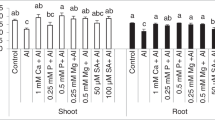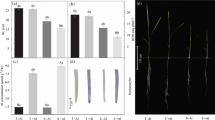Abstract
Aluminum (Al) toxicity is a major constraint for crop growth and production in tropical acidic soils, and organic acids (OAs) play a critical role in mitigating Al toxicity. However, the types of OAs secreted and Al tolerance varies across plants. To better understand the mechanisms that rubber trees use to mitigate Al toxicity, Reyan7-33-97 rubber tree tissue culture saplings were treated with different concentrations of AlCl3 to investigate the secretion of OAs under Al stress, along with the mitigation effects of exogenous OA application. The results showed that the pH value of root exudates was significantly decreased in response to the increase of Al concentration and duration, which resulted in 1.19–2.49 fold increases to total OA levels, particularly oxalic acid as its content was considerately higher than other OAs. When OAs, such as oxalic and malic acids were exogenously applied to Al treatment solutions, the rubber tree chlorophyll content, leaf relative water content and root activity were increased significantly, whereas the Al content in roots and leaves, antioxidant enzyme activities (POD, SOD), MDA and free proline contents decreased significantly in comparison with the Al treatment alone. Oxalic acid was found to be superior to malic acid in alleviating Al toxicity. Taken together, our results demonstrate that root secretion of OAs, particularly oxalic acid, under Al stress is a mechanism for rubber tree Al detoxification.




Similar content being viewed by others
Abbreviations
- Al:
-
Aluminum
- HPLC:
-
High-performance liquid chromatographic system
- MDA:
-
Malondialdehyde
- TBA:
-
Thiobarbituric acid
- TTC:
-
2, 3, 5-Triphenylte-trazolium chloride
- SOD:
-
Superoxide dismutase
- POD:
-
Peroxidase
- RWC:
-
Relative water content
- Chl:
-
Chlorophyll
- OAs:
-
Organic acids
- LLOQ:
-
Lower limit of quantification
- ULOQ:
-
Upper limit of quantification
References
Ma JF (2007) Syndrome of aluminum toxicity and diversity of aluminum resistance in higher plants. Int Rev Cyt 264:225–252
Famoso AN, Clark RT, Shaff JE, Craft E, McCouch SR, Kochian LV (2010) Development of a novel aluminum tolerance phenotyping platform used for comparisons of cereal aluminum tolerance and investigations into rice aluminum tolerance mechanisms. Plant Physiol 153(4):1678–1691
Kochian LV, Pineros MA, Liu J, Magalhaes JV (2015) Plant adaptation to acid soils: the molecular basis for crop aluminum resistance. Annu Rev Plant Biol 66:571–598
Zhang X, Long Y, Huang JJ, Xia JX (2019) Molecular mechanisms for coping with Al toxicity in plants. Int J Mol Sci 20(7):1551
Wang YQ, Yu WC, Cao Y, Cai YF, Lyi SM, Wu WW, Kang Y, Liang CY, Liu JP (2020) An exclusion mechanism is epistatic to an internal detoxification mechanism in aluminum resistance in Arabidopsis. BMC Plant Biol 20(1):122
Delhaize E, Ryan P, Randall PJ (1993) Aluminum tolerance in wheat (Triticum aestivum L.) (II. aluminum-stimulated excretion of malic acid from root apices). Plant Physiol 103:695–702
Hoekenga O, Vision T, Shaff J, Monforte A, Lee G, Howell S, Kochian L (2003) Identification and characterization of aluminum tolerance loci in Arabidopsis (Landsberg erecta × Columbia) by quantitative trait locus mapping. A physiologically simple but genetically complex trait. Plant Physiol 132:936–948
Pellet D, Grunes D, Kochian L (1995) Organic acid exudation as an aluminum-tolerance mechanism in maize (Zea mays L.). Planta 196:788–795
Yang ZM, Sivaguru M, Horst WJ, Matsumoto H (2010) Aluminium tolerance is achieved by exudation of citric acid from roots of soybean (Glycine max). Physiol Plant 110(1):72–77
Zhao Z, Ma JF, Takeda SK (2003) Differential Al resistance and citrate secretion in barley (Hordeum vulgare L.). Planta 217(5):794–800
Yang JL, Zheng SJ, He YF, Hideaki M (2005) Aluminium resistance requires resistance to acid stress: a case study with spinach that exudes oxalate rapidly when exposed to Al stress. J Exp Bot 56(414):1197–1203
Yang JL, Zhu XF, Peng YX, Zhang C, Feng M, Zheng SJ (2011) Aluminum regulates oxalate secretion and plasma membrane H+-ATPase activity independently in tomato roots. Planta 234(2):281–291
Zheng SJ (1998) High aluminum resistance in buckwheat (I. Al-induced specific secretion of oxalic acid from root tips). Plant Physiol 117:745–751
Yang LT, Qi YP, Jiang HX, Chen LS (2013) Roles of organic acid anion secretion in aluminium tolerance of higher plants. BioMed Res Int 2013:1–16
Zhang H, Zhang GL, Zhao YG, Zhao WJ, Qi ZP (2007) Chemical degradation of a ferralsol (oxisol) under intensive rubber (Hevea brasiliensis) farming in tropical China. Soil Till Res 93(1):109–116
Liu CA, Liang MY, Nie Y, Tang JW, Siddique KHM (2019) The conversion of tropical forests to rubber plantations accelerates soil acidification and changes the distribution of soil metal ions in topsoil layers. Sci Total Environ 696:134082
An F, Li CZ, Zhang TT, Wang LF, Wang JK, Xie GS (2018) Effects of aluminum toxicity on physiological and leaf chlorophyll fluorescent characteristics of rubber tree seedlings. Ying Yong Sheng Tai Xue Bao 29(12):4191–4198
Chen M, Chen YH, Shen ZG, Shen QR (2003) Alleviation of aluminum toxicity in wheat seedlings by exogenous organic acids. J Plant Physiol Mol Biol 29(4):281–288
Liu YH, Yu L, Chen XY, Li CB (2008) Alleviation of aluminum toxicity in rice seedlings by exogenous oxalic acid. J Hunan Agric Univ (Nat Sci) 34(3):281–283+340
Sun TG, Sha W, Zhang J (2009) Alleviation of aluminum toxicity in melon seedlings by exogenous oxalic acid. North Hortic (12):53–55
Guo N, Liu YM, Zhou WY, Liu YM, Zhang SN (2019) Alleviation of aluminum stress by exogenous oxalic acid in root system of Pinus massoniana Lamb. Acta Agric Zhejiangensis 31(7):1086–1095
Sun YX (2016) Study on the alleviating effects of exogenous organic acids on aluminum toxicity in watermelons. Master Thesis, Sichuang Agricultural University, Sichuan, China
Wang ZY, Liu P, Li JS, Wu HF, Liu Y, Lu BX (2011) Effects of exogenous organic acids on root morphology and chlorophyll fluorescence characteristics of oilseed rape under aluminum stress. Jiangsu J Agri Sci 27(4):756–762
Lu HL, Yan CL, Liu JC (2007) Low-molecular-weight organic acids exuded by mangrove (Kandelia candel (L.) Druce) roots and their effect on cadmium species change in the rhizosphere. Environ Expe Bot 61(2):159–166
Qian LW, Li QB, Sun JW, Feng Y (2018) Root secretion of organic acids and amino acids of evergreen poplar under aluminum stress. J Xiamen Univ Nat Sci 57(2):221–227
Liu YM (2018) The characteristics and rhizosphere effects in alleviating Al-toxicity of Pinus massoniana root exudation in acid-aluminum environment. Southwest Univ, Chongqing
Yuan J, Zhang N, Huang QW, Raza W, Li R, Vivanco JM, Shen QR (2015) Organic acids from root exudates of banana help root colonization of PGPR strain Bacillus amyloliquefaciens NJN-6. Sci Rep 5:13438
Kumari R, Ashraf S, Bagri G, Khatik S, Bagri D, Bagdi D (2018) Extraction and estimation of chlorophyll content of seed treated lentil crop using DMSO and acetone. J Pharmacogn Phytochem 7(3):249–250
Bates LS, Waldren RP, Teare ID (1973) Rapid determination of free proline for water-stress studies. Plant Soil 39(1):205–207
Zhan J, Li W, He HY, Li CZ, He LF (2014) Mitochondrial alterations during Al-induced PCD in peanut root tips. Plant Physiol Biochem 75:105–113
Yao SC, Huang WJ, Pan CL, Zhan J, He LF (2016) Caspase-like proteases regulate aluminum-induced programmed cell death in peanut. Plant Cell Tiss Org 127(3):691–703
An Y, Zhou P, Xiao Q, Shi DY (2014) Effects of foliar application of organic acids on alleviation of aluminum toxicity in alfalfa. J Plant Nutr Soil Sci 177(3):421–430
Ma JF, Hiradate S, Matsumoto H (1998) High aluminum resistance in buckwheat II. Oxalic acid detoxifies aluminum internally. Plant Physiol 117(3):753–759
Delhaize E (1993) Aluminum tolerance in wheat (Triticum aestivum L.) (II. aluminum-stimulated excretion of malic acid from root apices). Plant Physiol 103(3):695–702
Jorge RA, Arruda P (1997) Aluminum-induced organic acids exudation by roots of an aluminum-tolerant tropical maize. Phytochemistry 45(4):675–681
Jiang DX, Hou JJ, Gao WW, Tong X, Li M, Chu X, Chen GX (2021) Exogenous spermidine alleviates the adverse effects of aluminum toxicity on photosystem II through improved antioxidant system and endogenous polyamine contents. Ecotoxicol Environ Saf 207:111265
Li CS, Liu P, Xu GD, Zhang XY, He WB, Zhou DY (2006) Ameliorating effects of exogenous organic acids on aluminum toxicity in buckwheat seedlings. Acta Agron Sin 32(4):532–539
Hue NV (1986) Effect of organic acids on aluminum toxicity in subsoils. Soil Sci Soc Am J 50(1):28–34
Ma JF, Hiradate S, Nomoto K, Iwashita T, Matsumoto H (1997) Internal detoxification mechanism of Al in Hydrangea (identification of Al form in the leaves). Plant Physiol 113(4):1033–1039
Ma JF, Hiradate S (2000) Form of aluminium for uptake and translocation in buckwheat (Fagopyrum esculentum Moench). Planta 211(3):355–360
Acknowledgements
This work was supported by funds from the Hainan Provincial Basic and Applied-basic Research Program (Natural Science) for High-level Talents (2019RC326), the National Natural Science Foundation of China (31670633), the Earmarked Fund for China Agriculture Research System (CARS-33), and the Innovation Research Fund for Hainan Provincial Graduate Student (Hys2020-139).
Author information
Authors and Affiliations
Contributions
FA, JR and GX conceived the research, XM and FA designed the experimental procedures; XM conducted the experiment; XM and FA wrote the original manuscript; FA, ZL, ZL, JR and GX revised the manuscript. All the authors read and approved the final manuscript.
Corresponding authors
Ethics declarations
Conflict of interest
The authors declare no conflict interests in this study.
Additional information
Publisher's Note
Springer Nature remains neutral with regard to jurisdictional claims in published maps and institutional affiliations.
Rights and permissions
About this article
Cite this article
Ma, X., Liu, Z., Liu, Z. et al. Root secretion of oxalic and malic acids mitigates the rubber tree aluminum toxicity. J Rubber Res 24, 381–390 (2021). https://doi.org/10.1007/s42464-021-00105-8
Received:
Accepted:
Published:
Issue Date:
DOI: https://doi.org/10.1007/s42464-021-00105-8




